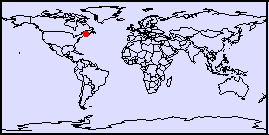 |
 |
 |
 |
Town/City: |
Fredericton |
State/Province: |
New Brunswick |
Country: |
Canada |
Latitude/Longitude: |
46N 66.5W |
Information supplied byJonathan Keizer
s5sb@unb.ca
|
|
The City of Fredericton is located in south-central New Brunswick, with the downtown core situated in the Saint John River Valley. The city is divided by the north and south banks of the Saint John River, with the downtown core located on the south side of the river. The river elevation near the city is normally 2.5 m above mean sea level.
The geology of the Saint John River Valley at Fredericton includes the presence of five unconsolidated geological units above bedrock. These five units include (from bedrock upward): buried sands and gravels; till deposits; glaciofluvial sands and gravels; lacustrine clayey silt; and fluvial sands and gravels. A cross-section of the Saint John River Valley is provided below. The most significant hydrogeologic units are the glaciofluvial sands and gravels, and the lacustrine clayey silt deposit. The glaciofluvial sands and gravels, which can be as thick as 50 m, form the Fredericton Aquifer.
The lacustrine clayey silt deposit, which can be as thick as 60 m, overlays the glaciofluvial sands and gravels. The clayey silt deposit may help to protect the aquifer from near-surface contaminant sources; however, this deposit has been found to be discontinuous. These discontinuities, termed "windows", allow direct hydraulic recharge from the surficial fluvial sands and gravels to the deeper Fredericton Aquifer.
The general groundwater flow direction in the Fredericton Aquifer is toward the downtown core of the city and the Wilmot Park Well Field, the main groundwater extraction site in the city. At specific locations there is a good hydraulic connection between the Saint John River (mean daily discharge of approximately 810 m3/s) and the Fredericton Aquifer. Recharge to the aquifer is a mixture of locally infiltrated surface water, from snowmelt and rainfall, and water from the Saint John River. It is estimated that approximately 66% of all the water extracted from the Wilmot Park Well Field is recharge from the river.
1) A groundwater protection plan for south Fredericton was developed in the early 1990s. Included in the plan are provisions to remove existing sources of potential contaminants such as residential oil storage tanks, as well as to prevent or improve the construction of potential contaminant sources in the future;
2) A groundwater treatment facility to remove excess manganese was constructed in 1984. This facility treats all groundwater extracted from the Wilmot Park Well Field.
City of Fredericton 1996 water pumping record. 1996 Annual report of the City Engineer, pp. 50-58.Hess, P.J., 1981. Groundwater use in Canada. Environment Canada - National Hydrology Research Institute, Paper No. 28, pp. 43.
Peters, L.P., 1993. Integration of information for ground water protection - a case study in Fredericton, New Brunswick. Proceedings of the 11th Canadian Hydrotechnical Conference, Canadian Society for Civil Engineering, Fredericton, New Brunswick, June, 1993, Vol.1, pp. 209-218.
Pupek, D.A., Craig, H.D., Schellenberg, D.H., 1993. An investigation into the distribution of dissolved tetrachloroethylene in an unconsolidated, surficial aquifer, Fredericton, N.B., using the hydropunch tool. Proceedings of the 11th Canadian Hydrotechnical Conference, Canadian Society for Civil Engineering, Fredericton, New Brunswick, June, 1993, Vol.1, pp. 257-265.
Thomas, N.E., Kan, K.T., Bray, D.I., MacQuarrie, K.T.B., 1994. Temporal changes in manganese concentrations in water from the Fredericton Aquifer, New Brunswick. Ground Water, Vol. 32, No. 4, pp. 650-656.
Violette, G.G., MacQuarrie, K.T.B., 1993. An urban aquifer and the presence of petroleum hydrocarbons. Proceedings of the 11th Canadian Hydrotechnical Conference, Canadian Society for Civil Engineering, Fredericton, New Brunswick, June, 1993, Vol.1, pp. 249-256.
| Laurie Corbett, P.Eng
Water and Sewer Engineer City of Fredericton Public Works Department PO Box 130 Fredericton, New Brunswick CANADA E3B 4Y7 Telephone: (506) 460-2038 Fax: (506) 460-2031 E-mail: corbettl@city.fredericton.nb.ca Web: http://www.city.fredericton.nb.ca |
Kerry MacQuarrie, PhD, P.Eng
Coordinator, Groundwater Studies Group University of New Brunswick Department of Civil Engineering PO Box 4400 Fredericton, New Brunswick CANADA E3B 5A3 Telephone: (506) 453-5121 Fax: (506) 453-3568 E-mail: ktm@unb.ca Web: http://www.unb.ca/civil/ |